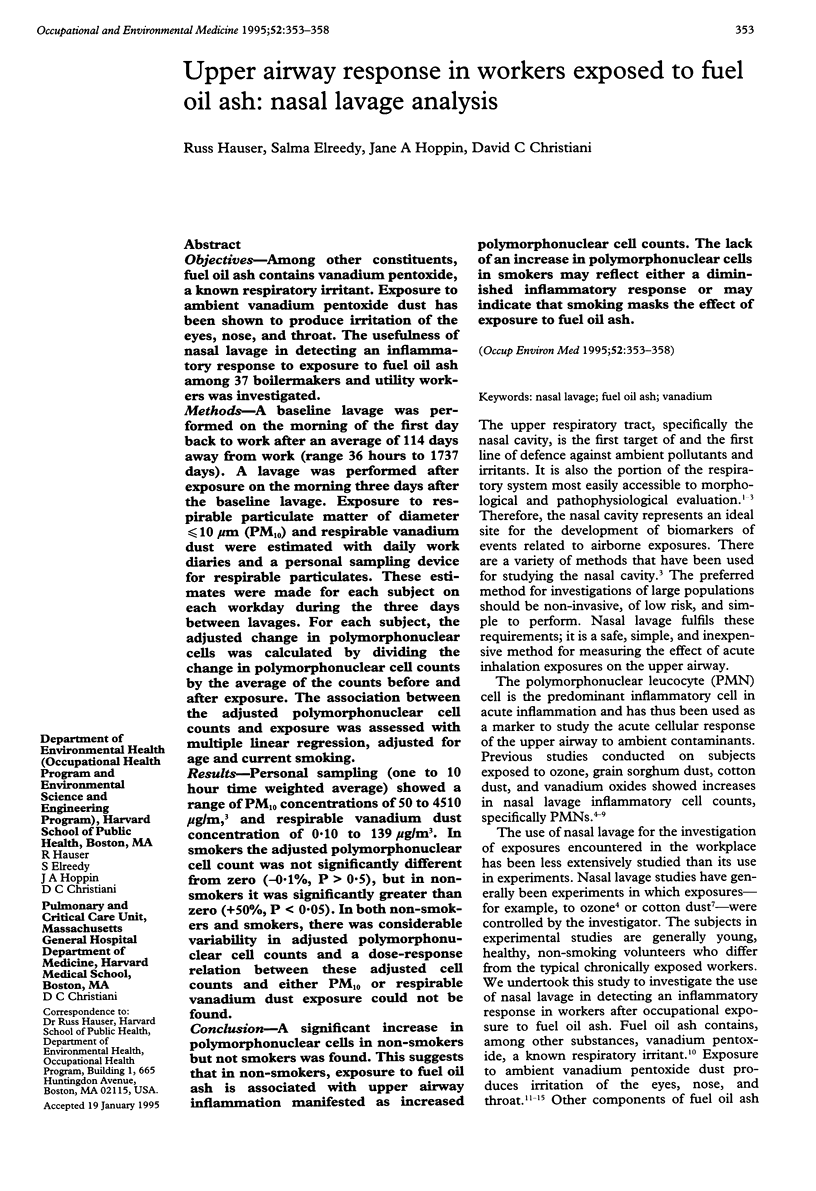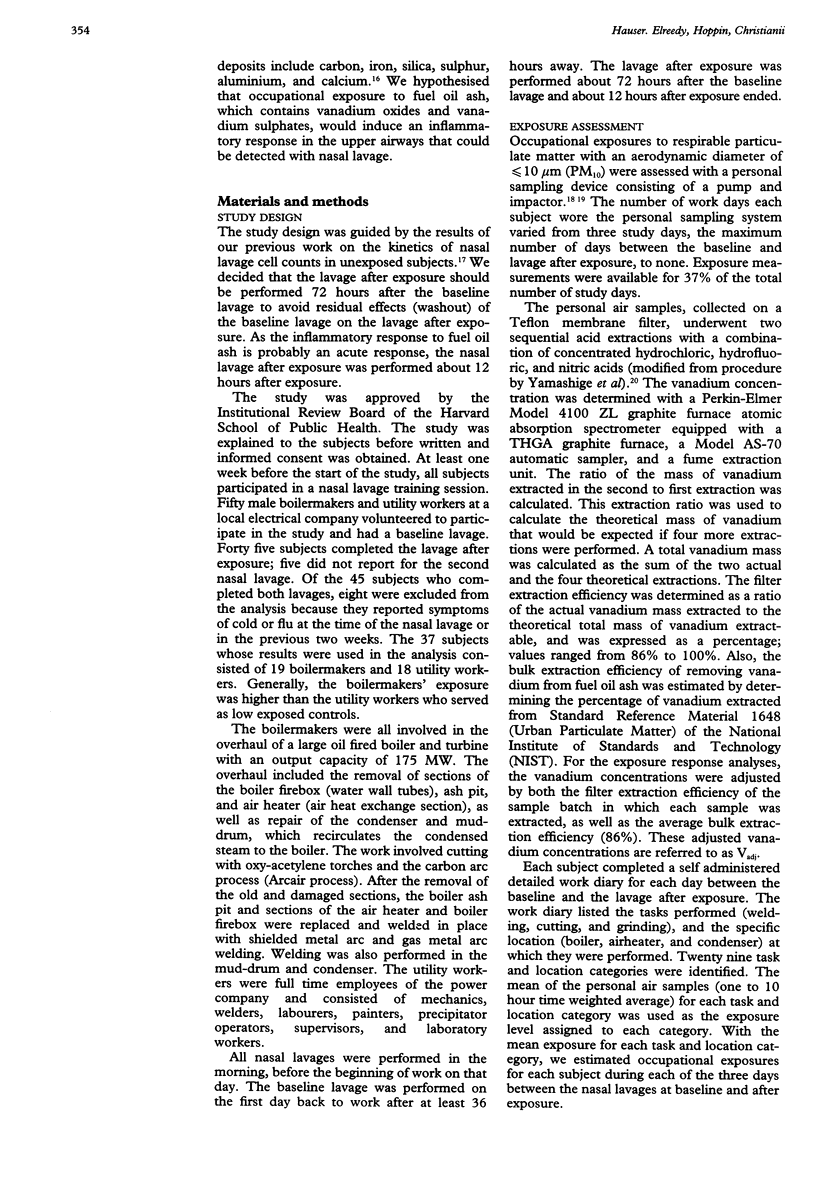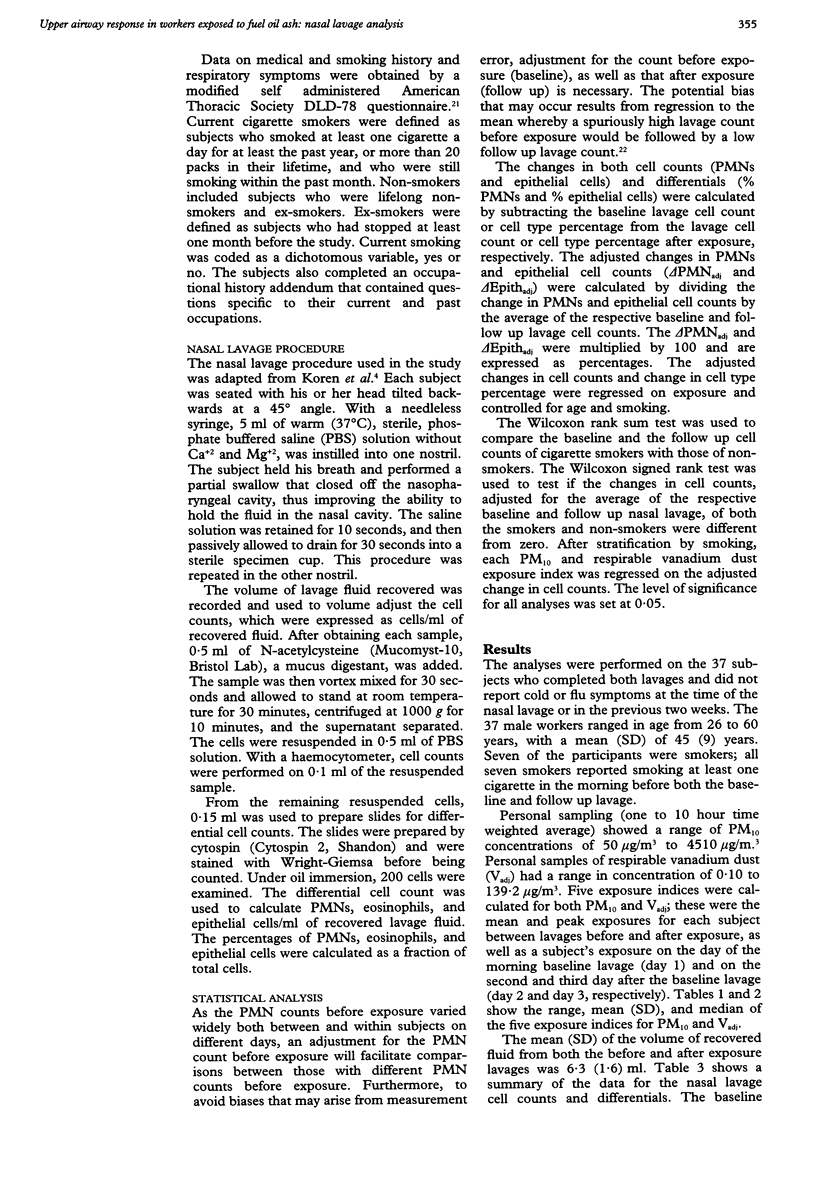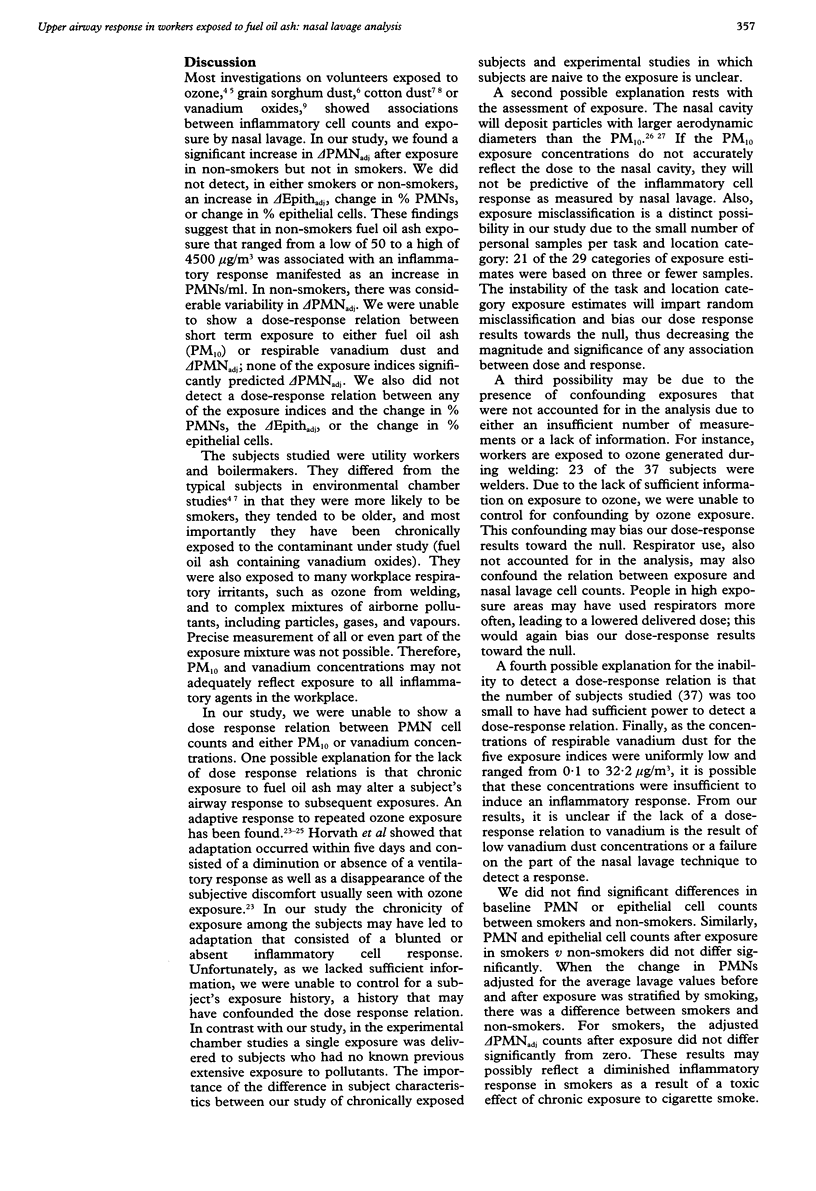Abstract
OBJECTIVES--Among other constituents, fuel oil ash contains vanadium pentoxide, a known respiratory irritant. Exposure to ambient vanadium pentoxide dust has been shown to produce irritation of the eyes, nose, and throat. The usefulness of nasal lavage in detecting an inflammatory response to exposure to fuel oil ash among 37 boilermakers and utility workers was investigated. METHODS--A baseline lavage was performed on the morning of the first day back to work after an average of 114 days away from work (range 36 hours to 1737 days). A lavage was performed after exposure on the morning three days after the baseline lavage. Exposure to respirable particulate matter of diameter < or = 10 microns (PM10) and respirable vanadium dust were estimated with daily work diaries and a personal sampling device for respirable particulates. These estimates were made for each subject on each workday during the three days between lavages. For each subject, the adjusted change in polymorphonuclear cells was calculated by dividing the change in polymorphonuclear cell counts by the average of the counts before and after exposure. The association between the adjusted polymorphonuclear cell counts and exposure was assessed with multiple linear regression, adjusted for age and current smoking. RESULTS--Personal sampling (one to 10 hour time weighted average) showed a range of PM10 concentrations of 50 to 4510 micrograms/m3, and respirable vanadium dust concentration of 0.10 to 139 micrograms/m3. In smokers the adjusted polymorphonuclear cell count was not significantly different from zero (-0.1%, P > 0.5), but in nonsmokers it was significantly greater than zero (+50%, P < 0.05). In both non-smokers and smokers, there was considerable variability in adjusted polymorphonuclear cell counts and a dose-response relation between these adjusted cell counts and either PM10 or respirable vanadium dust exposure could not be found. CONCLUSION--A significant increase in polymorphonuclear cells in non-smokers but not smokers was found. This suggests that in non-smokers, exposure to fuel oil ash is associated with upper airway inflammation manifested as increased polymorphonuclear cell counts. The lack of an increase in polymorphonuclear cells in smokers may reflect either a diminished inflammatory response or may indicate that smoking masks the effect of exposure to fuel oil ash.
Full text
PDF





Selected References
These references are in PubMed. This may not be the complete list of references from this article.
- Davis C. E. The effect of regression to the mean in epidemiologic and clinical studies. Am J Epidemiol. 1976 Nov;104(5):493–498. doi: 10.1093/oxfordjournals.aje.a112321. [DOI] [PubMed] [Google Scholar]
- Farrell B. P., Kerr H. D., Kulle T. J., Sauder L. R., Young J. L. Adaptation in human subjects to the effects of inhaled ozone after repeated exposure. Am Rev Respir Dis. 1979 May;119(5):725–730. doi: 10.1164/arrd.1979.119.5.725. [DOI] [PubMed] [Google Scholar]
- Ferris B. G. Epidemiology Standardization Project (American Thoracic Society). Am Rev Respir Dis. 1978 Dec;118(6 Pt 2):1–120. [PubMed] [Google Scholar]
- Folinsbee L. J., Bedi J. F., Horvath S. M. Respiratory responses in humans repeatedly exposed to low concentrations of ozone. Am Rev Respir Dis. 1980 Mar;121(3):431–439. doi: 10.1164/arrd.1980.121.3.431. [DOI] [PubMed] [Google Scholar]
- Frischer T. M., Kuehr J., Pullwitt A., Meinert R., Forster J., Studnicka M., Koren H. Ambient ozone causes upper airways inflammation in children. Am Rev Respir Dis. 1993 Oct;148(4 Pt 1):961–964. doi: 10.1164/ajrccm/148.4_Pt_1.961. [DOI] [PubMed] [Google Scholar]
- Graham D., Henderson F., House D. Neutrophil influx measured in nasal lavages of humans exposed to ozone. Arch Environ Health. 1988 May-Jun;43(3):228–233. doi: 10.1080/00039896.1988.9934938. [DOI] [PubMed] [Google Scholar]
- Hauser R., Garcia-Closas M., Kelsey K. T., Christiani D. C. Variability of nasal lavage polymorphonuclear leukocyte counts in unexposed subjects: its potential utility for epidemiology. Arch Environ Health. 1994 Jul-Aug;49(4):267–272. doi: 10.1080/00039896.1994.9937478. [DOI] [PubMed] [Google Scholar]
- Horvath S. M., Gliner J. A., Folinsbee L. J. Adaptation to ozone: duration of effect. Am Rev Respir Dis. 1981 May;123(5):496–499. doi: 10.1164/arrd.1981.123.5.496. [DOI] [PubMed] [Google Scholar]
- Kiviluoto M., Räsänen O., Rinne A., Rissanen M. Effects of vanadium on the upper respiratory tract of workers in a vanadium factory. A macroscopic and microscopic study. Scand J Work Environ Health. 1979 Mar;5(1):50–58. doi: 10.5271/sjweh.2666. [DOI] [PubMed] [Google Scholar]
- Koenig J. Q., Pierson W. E. Nasal responses to air pollutants. Clin Rev Allergy. 1984 Aug;2(3):255–261. doi: 10.1007/BF02991104. [DOI] [PubMed] [Google Scholar]
- Koren H. S., Hatch G. E., Graham D. E. Nasal lavage as a tool in assessing acute inflammation in response to inhaled pollutants. Toxicology. 1990 Jan-Feb;60(1-2):15–25. doi: 10.1016/0300-483x(90)90159-e. [DOI] [PubMed] [Google Scholar]
- Lees R. E. Changes in lung function after exposure to vanadium compounds in fuel oil ash. Br J Ind Med. 1980 Aug;37(3):253–256. doi: 10.1136/oem.37.3.253. [DOI] [PMC free article] [PubMed] [Google Scholar]
- Levy B. S., Hoffman L., Gottsegen S. Boilermakers' bronchitis. Respiratory tract irritation associated with vanadium pentoxide exposure during oil-to-coal conversion of a power plant. J Occup Med. 1984 Aug;26(8):567–570. [PubMed] [Google Scholar]
- Merchant J. A., Halprin G. M., Hudson A. R., Kilburn K. H., McKenzie W. M., Jr, Bermanzohn P., Hurst D. J., Hamilton J. D., Germino V. H., Jr Evaluation before and after exposure--the pattern of physiological response to cotton dust. Ann N Y Acad Sci. 1974;221:38–43. doi: 10.1111/j.1749-6632.1974.tb28196.x. [DOI] [PubMed] [Google Scholar]
- Pipkorn U., Karlsson G. Methods for obtaining specimens from the nasal mucosa for morphological and biochemical analysis. Eur Respir J. 1988 Oct;1(9):856–862. [PubMed] [Google Scholar]
- SJOBERG S. G. Vanadium bronchitis from cleaning oil-fired boilers. AMA Arch Ind Health. 1955 Jun;11(6):505–512. [PubMed] [Google Scholar]
- SJOBERG S. G. Vanadium dust, chronic bronchitis and possible risk of emphysema; a follow-up investigation of workers at a vanadium factory. Acta Med Scand. 1956 Jun 9;154(5):381–386. [PubMed] [Google Scholar]
- SJOBERG S. G. Vanadium pentoxide dust; a clinical and experimental investigation on its effect after inhalation. Acta Med Scand Suppl. 1950;238:1–188. [PubMed] [Google Scholar]
- Thomas K. W., Pellizzari E. D., Clayton C. A., Whitaker D. A., Shores R. C., Spengler J., Ozkaynak H., Froehlich S. E., Wallace L. A. Particle Total Exposure Assessment Methodology (PTEAM) 1990 study: method performance and data quality for personal, indoor, and outdoor monitoring. J Expo Anal Environ Epidemiol. 1993 Apr-Jun;3(2):203–226. [PubMed] [Google Scholar]
- WILLIAMS N. Vanadium poisoning from cleaning oil-fired boilers. Br J Ind Med. 1952 Jan;9(1):50–55. doi: 10.1136/oem.9.1.50. [DOI] [PMC free article] [PubMed] [Google Scholar]
- Witek T. J., Jr The nose as a target for adverse effects from the environment: applying advances in nasal physiologic measurements and mechanisms. Am J Ind Med. 1993 Nov;24(5):649–657. doi: 10.1002/ajim.4700240512. [DOI] [PubMed] [Google Scholar]
- Zenz C., Berg B. A. Human responses to controlled vanadium pentoxide exposure. Arch Environ Health. 1967 May;14(5):709–712. doi: 10.1080/00039896.1967.10664824. [DOI] [PubMed] [Google Scholar]


